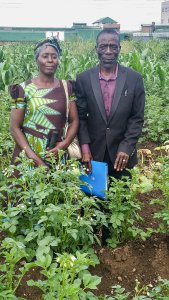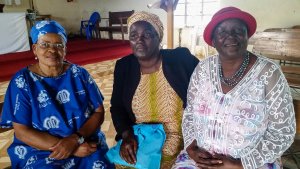Building resilience – strengthening the capacity of communities to survive shocks – is a key priority of the Anglican Alliance. But what makes communities resilient? What does resilience look like? What are its characteristics?
Here, Janice Proud, the Anglican Alliance’s relief manager, shares the findings from a grass-roots exploration of these questions in Zimbabwe. Janice has also been revising the Relief section of our website, where you will find a host of helpful information and resources and a whole new section on Resilience and Preparedness.
Stories from Zimbabwe
Individuals and communities can be seen to be thriving, not just surviving, as churches in Zimbabwe engage with their communities using Church and Community Mobilisation and other participatory processes.
Communities in Zimbabwe have suffered endless shocks in recent years, due to the political crisis and the impact of climate change. Generally people are surviving, but not thriving. However, using a range of participatory processes, churches in different parts of Zimbabwe are enabling their communities to live life to the full, to cope better with shocks and to feel stronger as individuals, as churches and as communities.
In January church leaders from Anglican and other churches across Zimbabwe gathered to explore what it means for individuals and communities to be resilient, to be able to withstand the shocks that are inevitable in life and to thrive despite the challenges. They were joined by a small group of partners, local and international, who support them in their work, including the Council of Anglican Provinces in Africa (CAPA), Christian Aid, Episcopal Relief & Development, Mothers’ Union, Tearfund and USPG, as well as the Anglican Alliance.
What does resilience look like in the community?
Participants explored together what resilience might look like in the community and what characterises a resilient community. Participants then visited churches in the provinces of Harare, Matabeleland and Manicaland to learn how they have been working with their communities. By visiting each other’s churches, participants heard stories about daily life and the impact of the church engaging with the community. The churches had all been working with their communities for several years using a range of participatory processes for asset based community development.
Communities told of the impact of the political crisis on people in Zimbabwe, including hyper-inflation wiping out the value of wages and pensions, and of climate change, causing prolonged drought but also flooding, affecting food security. As a consequence, people in the country have been struggling to earn a living, feed their families, keep their children in schools or buy medicines. Against this background, people told stories of hope and better lives from churches engaging with their communities.
The experience of St Christopher’s Church in Rugare
Janice visited St Christopher’s Church, Rugare, Diocese of Harare, where the Mothers’ Union has led the Church and Community Mobilisation Process (CCMP). Here she reflects on the stories of hope and transformation she encountered. “A young mother said that women traditionally stay behind to look after children, but now they are also doing projects and benefiting, providing for children. Another said that she had benefited a lot from CCMP; it has allowed children to go to school and be fed. Another talked about CCMP bringing unity to the women, with no segregation on religious or political lines as previously.”

Leobah translating for the visitors
“It was obvious from the dynamics within the community meeting that everyone felt part of the community, valued, respected, included. This included those living with HIV, the elderly, young mothers and young people,” said Janice. “A great example of this was Leobah Musikavanhu, who translated for the visitors with skill and energy, a task usually assigned to men. I have never seen it done by a young lady.”
You can see more about how the resilience of this community has been transformed through CCMP in this video.
Looking more deeply at resilience characteristics
Back in Harare, participants shared the key stories from their field visits, identifying the factors contributing to resilience and the impact these had locally.
The most important resilience characteristics were identified as community cohesion and human capacity / capital. Factors contributing to community cohesion included relationships, community-co-operation, unity, religious co-operation and spiritual development; human capacity /capital mostly comprised transformed attitudes, inclusion and spiritual growth.
Surprisingly, these people-focused factors were seen as greater contributors to resilience than factors such as diversified livelihoods and land management – even though these were still identified as important. Resilience is therefore about more than practical and physical preparedness; transformed individuals and cohesive communities are key. The word cloud shows some of the sub categories of resilience that the stories from the communities highlighted.
Stories of improved resilience, but also challenges
The stories from the communities across the country reported that the participatory community processes improved the resilience of their community. The stories were many and moving, such as increased household income due to individual and group projects, innovation such as making safe cages for road runners (chickens) so as to protect the chicks, increased nutrition and self reliance, decreased stigma for those living with HIV, decreased gender based violence helped by women having their own income and being more independent, increased spiritual growth, strengthened relationships with other community members, increased happiness, confidence and pride, decreased financial concerns.
Of course there were challenges shared as well, but the community had learnt how to come together to talk about issues, to network and work through challenges. Issues highlighted included lack of market linkages, incessant drought, lack of extension services for technical support.
You can read a more detailed account of the learning from Zimbabwe, including reflection on the importance of good facilitation, here.
Building Resilience throughout the Anglican Communion
Building resilience strengthens communities so that they are less impacted when shocks hit them. The Anglican Alliance is prioritising supporting local churches to build their capacity in resilience and disaster preparedness. A key tool in this endeavour is the Pastors and Disasters toolkit – a resource for trainers and facilitators.
The Pastors and Disasters toolkit was developed by a team from Anglican churches and agencies around the world, facilitated by Episcopal Relief & Development, as a participatory resource for churches to engage with their communities to look at their context, the risks their communities face, how they can mitigate those risks and how they can prepare to respond should an emergency hit their community. It has been used successfully in several parts of the world with a really positive impact on communities through the preparedness and improved response of the local church after an emergency. A good example is the Church of Ceylon in Sri Lanka. You can learn more from this video or the web story here.
To learn more, visit our new Resilience and Preparedness web page, part of our revised and Preparedness web page, part of our revised Relief web pages.
To share your story or find out if any activities are planned in your region, please contact your Anglican Alliance regional facilitator or the Alliance relief manager, email anglicanalliance@aco.org

